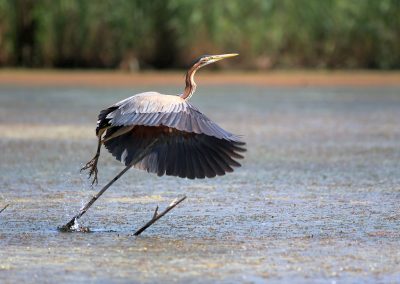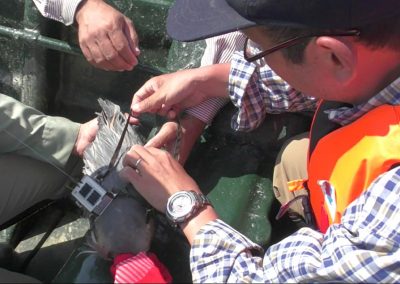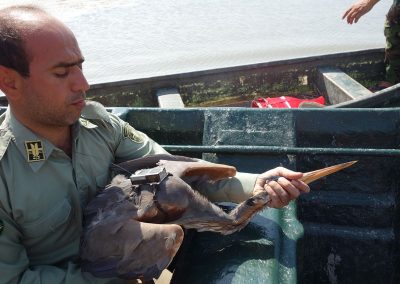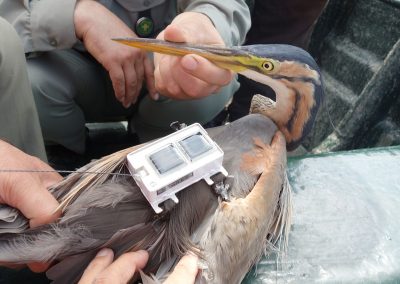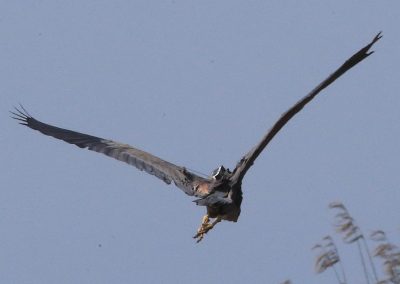The Anzali Wetland is very important habitat for many migratory birds as a wintering, breeding and stopover site. However, migratory routes of the birds in the Anzali Wetland are almost unknown. In order to identify the migratory routes of migratory birds in the Anzali Wetland, satellite-tracking survey by using ARGOS system was planned as a part of comprehensive ecosystem survey, which is the Joint Pilot Activity of the project.
Argos system is a global satellite-based location and data collection system from Platform Terminal Transmitters, PTTs dedicated to studying and protecting planet’s environment. The satellite catches radio wave from the PTTs and informs the coordinates of PTTs to users.
Purple Heron (Ardea purpurea) was selected as target bird to track the migratory route. The Purple Heron is very beautiful bird with dark grey with black belly, chestnut on neck edged by black streak, black crown and line across cheeks; dull yellow bill. The Heron is breeding in the Anzali Wetland. According to the result of bird breeding survey (one of Joint Pilot Activity) conducted in 2015 by Dr.Moradi ,Professor in Gorgan university, and Mr.Ashoori ,bird expert of DOE, about 120 nests were found in reed bed of the Anzali Wetland. Purple Heron generally breeds in Iran including coast area of Caspian Sea, and winters in Sub-Saharan Africa or South Asia. It is very important to identify the wintering site and migration route of Purple Heron. We should conserve these travelers from northern countries as a symbol of the wetland.
Three adult Purple Herons were captured by Mr.Alinezhad and Mr.Pourmojib, who is DOE expert, and their team on 29th and 30th May, 2017 at their nests in the west lagoon of the Anzali Wetland. Mr.Watanabe ,who is in charge of wetland ecosystem conservation of JICA Expert Team, attached PTTs with Herons. PTTs with 40g weight were developed by Nomad Science Inc. in Japan. Three Purple Herons with PTTs were released at West Lagoon.
The project team has already received information from the Argos system that all Herons are still in the Anzali Wetland as of 30th May 2017. They will continue to stay in the Anzali Wetland in summer and then they will leave to wintering site in southern countries in autumn./] is a global satellite-based location and data collection system from Platform Terminal Transmitters, PTTs dedicated to studying and protecting planet’s environment. The satellite catches radio wave from the PTTs and informs the coordinates of PTTs to users.
Purple Heron (Ardea purpurea) was selected as target bird to track the migratory route. The Purple Heron is very beautiful bird with dark grey with black belly, chestnut on neck edged by black streak, black crown and line across cheeks; dull yellow bill. The Heron is breeding in the Anzali Wetland. According to the result of bird breeding survey (one of Joint Pilot Activity) conducted in 2015 by Dr.Moradi ,Professor in Gorgan university, and Mr.Ashoori ,bird expert of DOE, about 120 nests were found in reed bed of the Anzali Wetland. Purple Heron generally breeds in Iran including coast area of Caspian Sea, and winters in Sub-Saharan Africa or South Asia. It is very important to identify the wintering site and migration route of Purple Heron. We should conserve these travelers from northern countries as a symbol of the wetland.
Three adult Purple Herons were captured by Mr.Alinezhad and Mr.Pourmojib, who is DOE expert, and their team on 29th and 30th May, 2017 at their nests in the west lagoon of the Anzali Wetland. Mr.Watanabe ,who is in charge of wetland ecosystem conservation of JICA Expert Team, attached PTTs with Herons. PTTs with 40g weight were developed by Nomad Science Inc. in Japan. Three Purple Herons with PTTs were released at West Lagoon.
The project team has already received information from the Argos system that all Herons are still in the Anzali Wetland as of 30th May 2017. They will continue to stay in the Anzali Wetland in summer and then they will leave to wintering site in southern countries in autumn.


